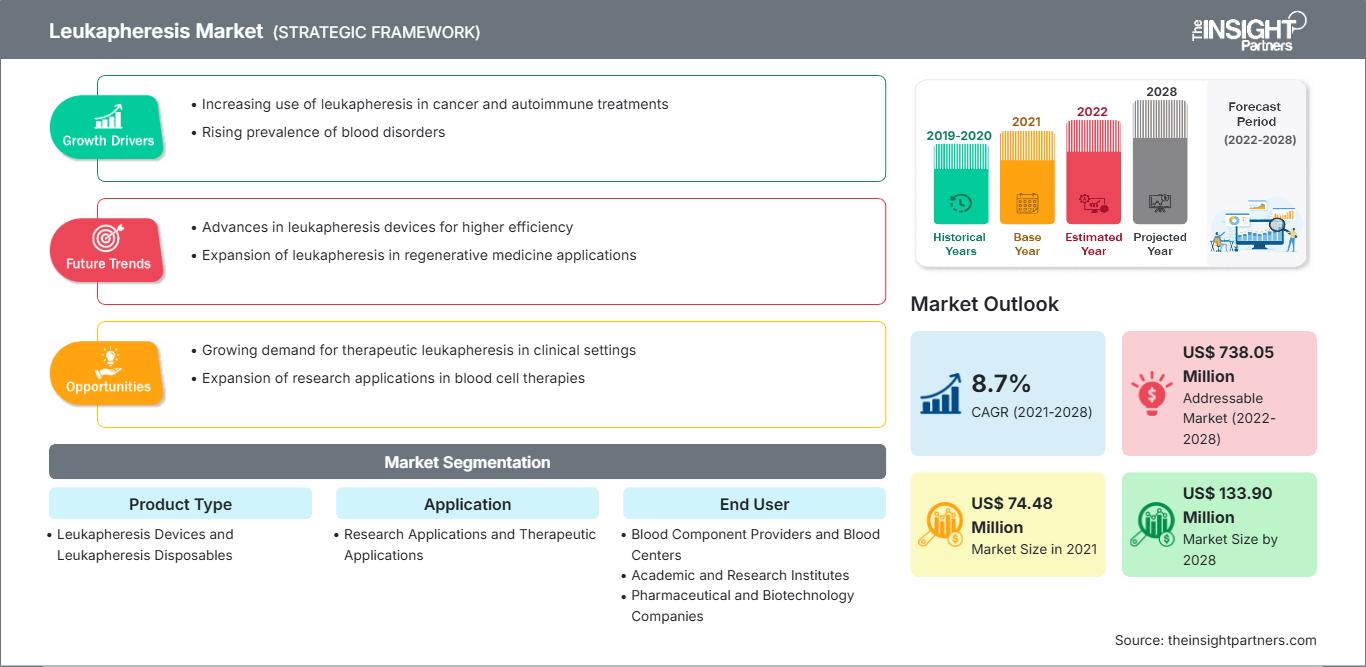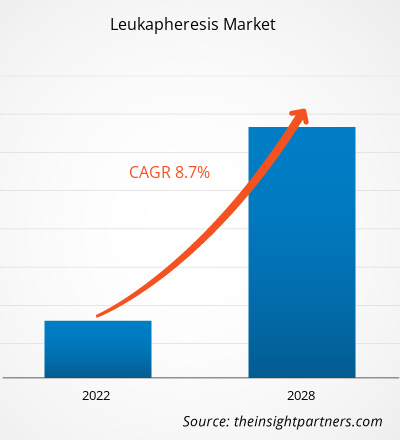[Forschungsbericht]Der Leukapherese-Markt soll von 74,48 Millionen US-Dollar im Jahr 2021 auf 133,90 Millionen US-Dollar im Jahr 2028 anwachsen; das Wachstum wird von 2021 bis 2028 auf durchschnittlich 8,7 % geschätzt.
Leukapherese ist ein Verfahren, bei dem weiße Blutkörperchen (Leukozyten), die an der körpereigenen Immunantwort beteiligt sind, aus einer Blutprobe isoliert werden. Es handelt sich um eine besondere Form der Apherese, bei der ein Bestandteil des Blutes, beispielsweise rote Blutkörperchen oder Blutplättchen, gewonnen wird, während das restliche Blut wieder in den Kreislauf zurückgeführt wird. Leukapherese wird häufig eingesetzt, um sehr hohe Leukozytenzahlen zu senken, beispielsweise bei chronischem Blutkrebs wie der chronischen lymphatischen Leukämie (CLL). Sie kann auch durchgeführt werden, um weiße Blutkörperchen für eine spätere Transplantation zu gewinnen, beispielsweise um einen plötzlichen Rückgang der Leukozytenzahlen während einer Chemotherapie zu bewältigen. Eine weitere Anwendung ist die Verwendung als Bestandteil einer neuartigen Immuntherapie, der sogenannten chimären Antigenrezeptor (CAR)-T-Zelltherapie, zur Bekämpfung von Leukämie, Prostatakrebs und anderen Krebsarten. Die Leukapherese kann an der Person durchgeführt werden, die die Behandlung beantragt (autologe Apherese), oder an einem Spender für eine spätere Transplantation (allogene Apherese). Derzeit wird die Leukapherese häufig zur Behandlung verschiedener Krankheiten eingesetzt und dient auch zu diagnostischen Zwecken, da sie die Ausbeute an zirkulierenden Tumorzellen erhöhen kann. Faktoren wie die steigende Zahl freiwilliger Blutspender, die zunehmende Inzidenz hämatologischer Erkrankungen und die zunehmende Überalterung der Bevölkerung treiben das Wachstum des Leukapherese-Marktes voran. Die hohen Kosten der Leukapherese behindern das Marktwachstum jedoch in gewissem Maße.
Passen Sie diesen Bericht Ihren Anforderungen an
Sie erhalten kostenlos Anpassungen an jedem Bericht, einschließlich Teilen dieses Berichts oder einer Analyse auf Länderebene, eines Excel-Datenpakets sowie tolle Angebote und Rabatte für Start-ups und Universitäten.
Leukapherese-Markt: Strategische Einblicke

-
Holen Sie sich die wichtigsten Markttrends aus diesem Bericht.Dieses KOSTENLOSE Beispiel umfasst Datenanalysen, die von Markttrends bis hin zu Schätzungen und Prognosen reichen.
Bluttransfusionen sind ein integraler Bestandteil der nationalen Gesundheitsinfrastruktur und -politik vieler Länder. Fortschritte in der Medizinbranche haben zu Verbesserungen der Behandlungsmethoden bei schweren Krankheiten und Verletzungen geführt, was letztendlich den Bedarf an Bluttransfusionen für das Überleben der Patienten erhöht hat. Das wachsende Bewusstsein für die Bedeutung von Bluttransfusionen und die Blutverfügbarkeit im Gesundheitswesen hat zu einem Anstieg der Zahl der Menschen geführt, die bereit sind, ihr Blut für medizinische Zwecke zu spenden. Laut Daten der Weltgesundheitsorganisation (WHO) wurden im Jahr 2018 weltweit ca. 117,4 Millionen Blutspenden gemeldet. Blutspender werden üblicherweise in freiwillige unbezahlte, bezahlte und Familien-/Ersatzspender eingeteilt, und laut WHO sind freiwillige/unbezahlte Spender die Hauptquelle für eine zuverlässige und ausreichende Blutversorgung. Laut WHO-Daten aus dem Jahr 2019 stiegen die Blutspenden von freiwilligen unbezahlten Spendern zwischen 2008 und 2015 in 139 Ländern weltweit um 11,6 Millionen. Auch in Ländern mit niedrigem und mittlerem Einkommen gewinnt der Trend zur Blutspende deutlich an Bedeutung. Laut den Daten, die während der CAG-Jahresversammlung 2017 vorgestellt wurden, wurden im Jahr 2016 rund 13.000 Eingriffe an 1.087 Patienten durchgeführt. Den stärksten Anstieg der Zahl freiwilliger Blutspender gab es in südostasiatischen Ländern (83 %) und Amerika (70 %).
In vielen Ländern entwickelte und eingeführte nationale Programme ziehen zusätzlich eine große Zahl von Thrombozyten- und Blutspendern an. In Indien beispielsweise ist der National Blood Transfusion Council (NBTC), der Teil der National AIDS Control Organization (NACO) ist, das zentrale Gremium, das die Koordination mit den State Blood Transfusion Councils (SBTCs) übernimmt, die wiederum bei den State AIDS Control Societies (SACS) angesiedelt sind. Der NBTC unterstützt Gesundheitsprogramme für verschiedene Aktivitäten im Zusammenhang mit Bluttransfusionsdiensten (BTS). Die steigende Zahl geeigneter Spender in verschiedenen Ländern weltweit erhöht den Bedarf an Leukapherese-Geräten zur Trennung der benötigten Blutbestandteile.
Produkttypbasierte Erkenntnisse
Basierend auf dem Produkttyp ist der Leukapherese-Markt in Leukapherese-Geräte und Leukapherese-Einwegartikel unterteilt. Im Jahr 2021 hatte das Segment der Leukapherese-Einwegartikel einen größeren Marktanteil. Es wird jedoch erwartet, dass das Segment der Leukapherese-Geräte zwischen 2021 und 2028 eine höhere durchschnittliche jährliche Wachstumsrate (CAGR) verzeichnet.
Anwendungsbasierte Erkenntnisse
Der Leukapherese-Markt ist nach Anwendung in Forschungsanwendungen und therapeutische Anwendungen unterteilt. Im Jahr 2021 hatte das Segment Forschungsanwendungen einen größeren Marktanteil, und für dasselbe Segment wird in den kommenden Jahren eine höhere durchschnittliche jährliche Wachstumsrate (CAGR) erwartet.
Endnutzerbasierte Erkenntnisse
Der Leukapherese-Markt ist nach Endnutzern in Pharma- und Biotechnologieunternehmen, Hochschul- und Forschungsinstitute, Blutkomponentenanbieter und Blutspendezentren sowie Krankenhäuser und Transfusionszentren unterteilt. Im Jahr 2021 hatte das Segment der Blutkomponentenanbieter und Blutspendezentren den größten Marktanteil. Auf der anderen Seite wird für das Segment der Krankenhäuser und Transfusionszentren in den kommenden Jahren die höchste durchschnittliche jährliche Wachstumsrate (CAGR) erwartet.
Unternehmen, die im Leukapherese-Markt tätig sind, verfolgen Strategien wie Produkteinführungen, Fusionen und Übernahmen, Kooperationen, Produktinnovationen und die Erweiterung ihres Produktportfolios, um ihre Präsenz weltweit auszubauen, ihren Markennamen zu wahren und die wachsende Nachfrage der Endnutzer zu befriedigen.
Leukapherese
Regionale Einblicke in den Leukapherese-MarktDie Analysten von The Insight Partners haben die regionalen Trends und Faktoren, die den Leukapherese-Markt im Prognosezeitraum beeinflussen, ausführlich erläutert. In diesem Abschnitt werden auch die Marktsegmente und die geografische Lage in Nordamerika, Europa, dem asiatisch-pazifischen Raum, dem Nahen Osten und Afrika sowie Süd- und Mittelamerika erörtert.
Umfang des Leukapherese-Marktberichts
| Berichtsattribut | Einzelheiten |
|---|---|
| Marktgröße in 2021 | US$ 74.48 Million |
| Marktgröße nach 2028 | US$ 133.90 Million |
| Globale CAGR (2021 - 2028) | 8.7% |
| Historische Daten | 2019-2020 |
| Prognosezeitraum | 2022-2028 |
| Abgedeckte Segmente |
By Produkttyp
|
| Abgedeckte Regionen und Länder |
Nordamerika
|
| Marktführer und wichtige Unternehmensprofile |
|
Dichte der Akteure auf dem Leukapherese-Markt: Verständnis ihrer Auswirkungen auf die Geschäftsdynamik
Der Leukapherese-Markt wächst rasant, angetrieben durch die steigende Endverbrauchernachfrage aufgrund von Faktoren wie sich entwickelnden Verbraucherpräferenzen, technologischem Fortschritt und einem stärkeren Bewusstsein für die Produktvorteile. Mit steigender Nachfrage erweitern Unternehmen ihr Angebot, entwickeln Innovationen, um den Verbraucherbedürfnissen gerecht zu werden, und nutzen neue Trends, was das Marktwachstum weiter ankurbelt.

- Holen Sie sich die Leukapherese-Markt Übersicht der wichtigsten Akteure
- Leukapheresegeräte
- Apheresegeräte
- Leukapheresesäulen und Zellseparatoren
- Leukoreduktionsfilter
- Leukapherese-Einwegartikel
Leukapheresemarkt – nach Anwendung
- Forschungsanwendungen
- Therapeutische Anwendungen
Leukapheresemarkt – nach Endverbraucher
- Pharma- und Biotechnologieunternehmen
- Akademische und Forschungsinstitute
- Blutkomponentenanbieter und Blutspendezentren
- Krankenhäuser und Transfusionszentren
Leukapheresemarkt – nach Geografie
-
Nordamerika
- USA
- Kanada
- Mexiko
-
Europa
- Frankreich(APAC)
- China
- Indien
- Südkorea
- Japan
- Australien
- Übriger Asien-Pazifik-Raum
-
Naher Osten und Asien Afrika (MEA)
- Südafrika
- Saudi-Arabien
- VAE
- Übriger Naher Osten und andere Länder. Afrika
-
Südamerika (SAM)
- Brasilien
- Argentinien
- Restliches Süd- und Mittelamerika
Unternehmensprofile
- Asahi Kasei Corporation
- Fresenius SE & Co. KGaA
- Haemonetics Corporation
- Terumo Corporation
- STEMCELL Technologies Inc.
- HemaCare
- Macopharma
- AllCells
- STEMEXPRESS
- BioIVT
- Frankreich(APAC)
- Historische Analyse (2 Jahre), Basisjahr, Prognose (7 Jahre) mit CAGR
- PEST- und SWOT-Analyse
- Marktgröße Wert/Volumen – Global, Regional, Land
- Branchen- und Wettbewerbslandschaft
- Excel-Datensatz
Aktuelle Berichte
Erfahrungsberichte
Grund zum Kauf
- Fundierte Entscheidungsfindung
- Marktdynamik verstehen
- Wettbewerbsanalyse
- Kundeneinblicke
- Marktprognosen
- Risikominimierung
- Strategische Planung
- Investitionsbegründung
- Identifizierung neuer Märkte
- Verbesserung von Marketingstrategien
- Steigerung der Betriebseffizienz
- Anpassung an regulatorische Trends






















 Kostenlose Probe anfordern für - Leukapherese-Markt
Kostenlose Probe anfordern für - Leukapherese-Markt